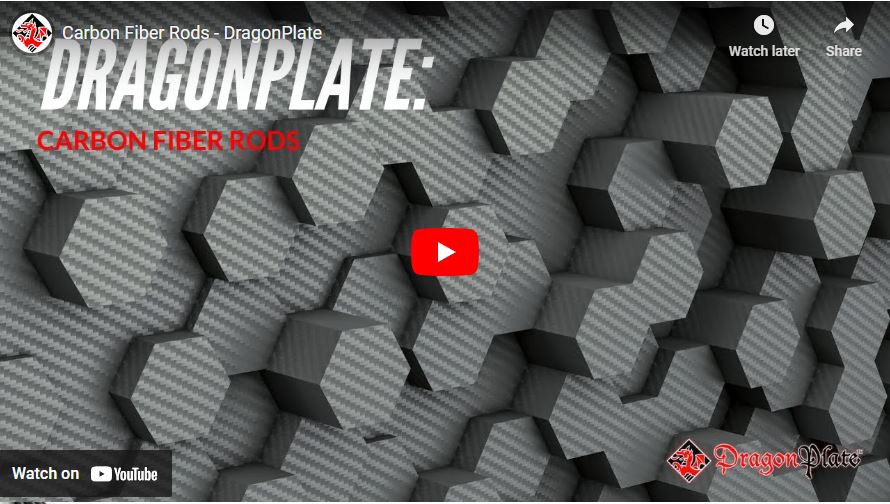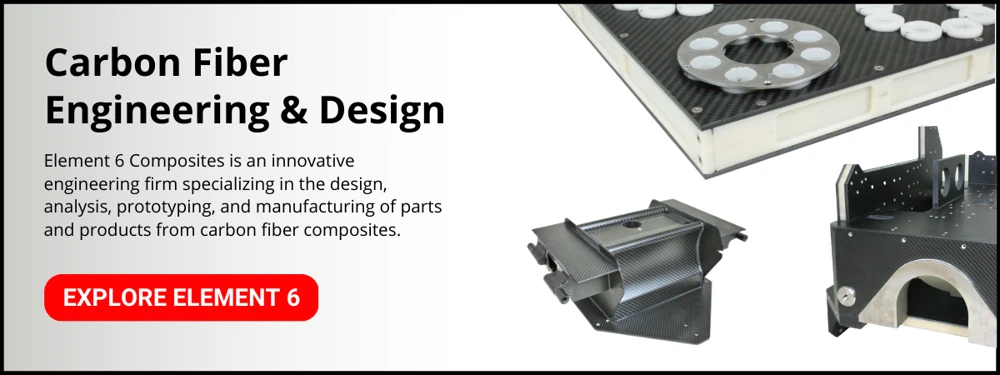An Introduction to Carbon Fiber Rods
Both hobbyists and professionals find carbon fiber rods to be useful building blocks for any number of structures. Because carbon fiber is so rigid, carbon fiber rods are an excellent choice for any application where stiffness and lightness are important. Carbon fiber rods can be as little as ⅓ the weight of a comparable aluminum rod with similar or better strength characteristics.
How Carbon Fiber Rods Are Made
Carbon fiber rods are manufactured by pulling continuous carbon fibers mixed with epoxy resin through heated forming dies, a process known as pultrusion. Pultrusion is similar to the extrusion process used with aluminum and thermoplastic. Through this process, continuous lengths of carbon fiber rods with constant cross-sections can be created, and they take on the shape of the die. As the carbon fibers are pulled through the die and saturated with epoxy resin, the heat from the die begins the resin-hardening, or polymerization, process.
The advantages to using pultrusion to create carbon fiber rods include:
High axial strength and stiffness
Straight and parallel fiber alignment
Tightly controlled cross-section dimensions
Smooth surface
Limitless length
The extrusion process produces straight, rigid, lightweight rods with a low coefficient of thermal expansion. As with all carbon fiber products, rods have a high stiffness-to-weight ratio. They also boast exceptional linear strength because most of the carbon fibers run along the length of the rod on the 0° axis.
Uses for Carbon Fiber Rods
Carbon fiber rods are an excellent choice for creating lightweight frame constructions. They are therefore often found in structural space frames and trusses. Many remote control (RC) enthusiasts find carbon fiber rods to be the perfect material from which to construct their models. Rods are an excellent material for building engineered and high-performance structures, particularly when combined with carbon fiber laminates. Generally speaking, carbon fiber rods perform particularly well in bending and axial tension or compression applications.
When using rods as structural components in mechanical assemblies, engineers are typically looking for strong, lightweight materials to provide strength and stability. Rods are basic building blocks for many structures, and this product replaces steel and aluminum rods because they are lighter and stronger than either material. Here is a closer look at three common uses for carbon fiber rods.
Carbon Fiber Rods in Frame Construction
Carbon fiber rods possess a high stiffness-to-weight ratio (specific tensile modulus) that makes them the perfect choice for use in lightweight frame constructions. Frames and trusses are often built using carbon fiber rods as the reinforcing material. Carbon fiber components don’t rust and are resistant to many solvents and chemicals. This makes them great for use in industrial framed structures, and other frame-type structures that come into contact with elements or chemicals.
In the stringed instrument industry, luthiers use carbon fiber rods as truss rods to reinforce their instrument necks. This fixes or prevents the neck from twisting or bowing. Carbon fiber rods are also used to reinforce pegheads in instruments like ukuleles and cellos.
Carbon Fiber Rods in Remote Control Projects
Check out any RC message board and carbon fiber will be on it. Remote control hobbyists are particularly fond of carbon fiber rods for the construction of their projects. Whether they are building RC cars, planes, helicopters, drones, or something else, carbon fiber’s lightweight strength routinely is the difference between the project working or not. Here are a few examples:
Strengthening the overall RC project
Building a frame
Creating a tail boom
RC enthusiasts find many uses for carbon fiber rods in all sizes. Drones, in particular, benefit from this strong, lightweight material. The use of carbon fiber can mean the difference between getting off the ground or not, or surviving a crash. With a high Young’s Modulus (ratio of stress/strain) and a density of 1.5 g/cm3, carbon fiber is the perfect material.
Carbon Fiber Rods in Engineering and High-Performance Structures
When combined with carbon fiber laminates, carbon fiber rods are an ideal material for use in building engineered structures. They perform particularly well under bending and tensile or compressive loads, though it is important to understand that carbon fiber rods do not handle high torque or crushing loads well. The carbon fiber characteristics of strength and rigidity make it a particularly useful material in civil engineering applications. Carbon fiber rods can be used to strengthen and reinforce concrete, steel, timber, and masonry.
Engineers working in the construction industry are always trying to adopt improved materials for sustainability. One such application is the carbon fiber reinforced polymer (CFRP) rebar. This type of carbon fiber rod is often used as an alternative to steel reinforcement in concrete structures such as:
Parking garages
Bridges
Highways located in extreme environments
Structures that are susceptible to corrosion.
There are a number of reasons that civil engineers are increasingly using carbon fiber. Here are a few:
Light weight
Higher tensile strength than steel
Resistance to chemical corrosion
From hobbyists to professionals, from bicycles to parking garages, carbon fiber rods have an incredible number of uses in today’s world.
Working with Carbon Fiber Rods
Rods are relatively easy to work with. As with any building project, having the right tools on hand makes the job that much safer and simpler. However, there are many tools that can be used to work with carbon fiber rods. A good quality fine-toothed band saw, coping saw, scroll saw, end mill, or Dremel tool will make quick work of cutting carbon fiber rods to the exact length needed for your project. Since they are pultruded in an epoxy matrix, they can be easily bonded together easily using epoxy resin.
Due to their rigidity, light weight, and strength, carbon fiber rods are often used to frame projects when stiffness and weight count. The extrusion process used to manufacture carbon fiber rods offers significant advantages for applications where precision counts. The pultrusion process offers the ability to create custom, smooth rods that can be cut to any length. The tools needed to cut and bond carbon fiber rods are readily available in the garages of most enthusiasts and handymen. It is no wonder, then, that carbon fiber rods are often the preferred choice for both hobbyists and professionals alike.
For a full list of rods for purchase, see our Carbon Fiber Rods category.

